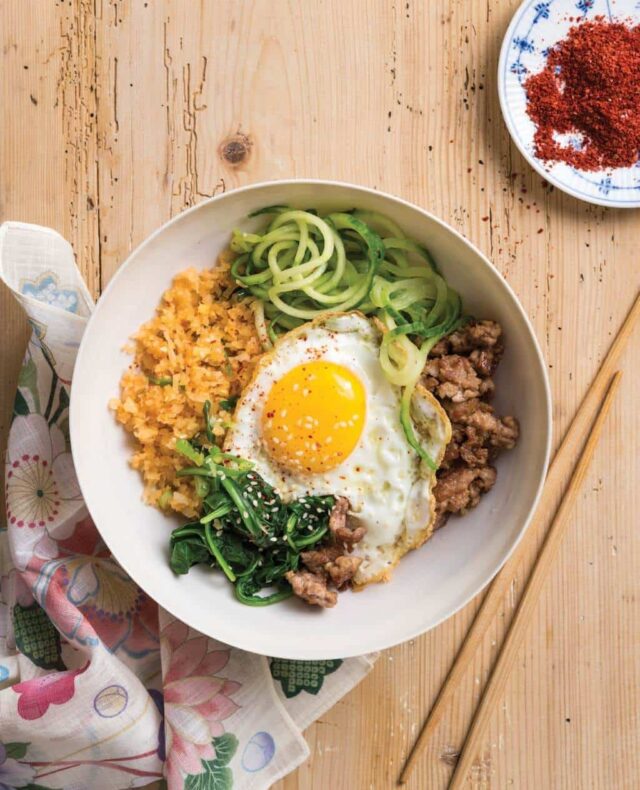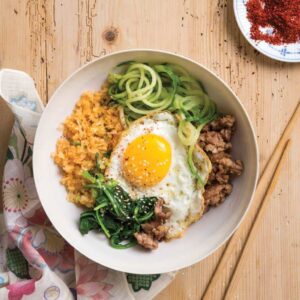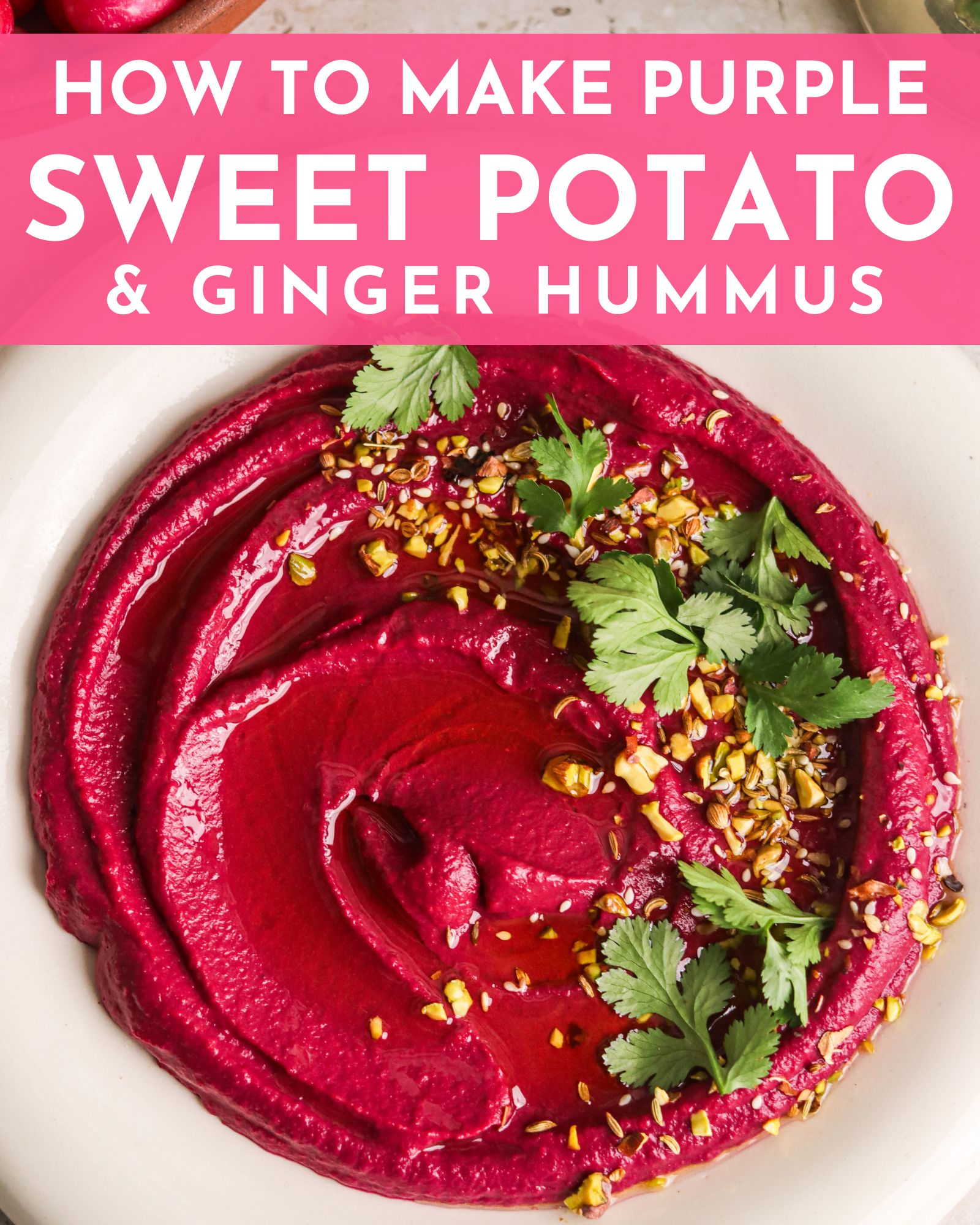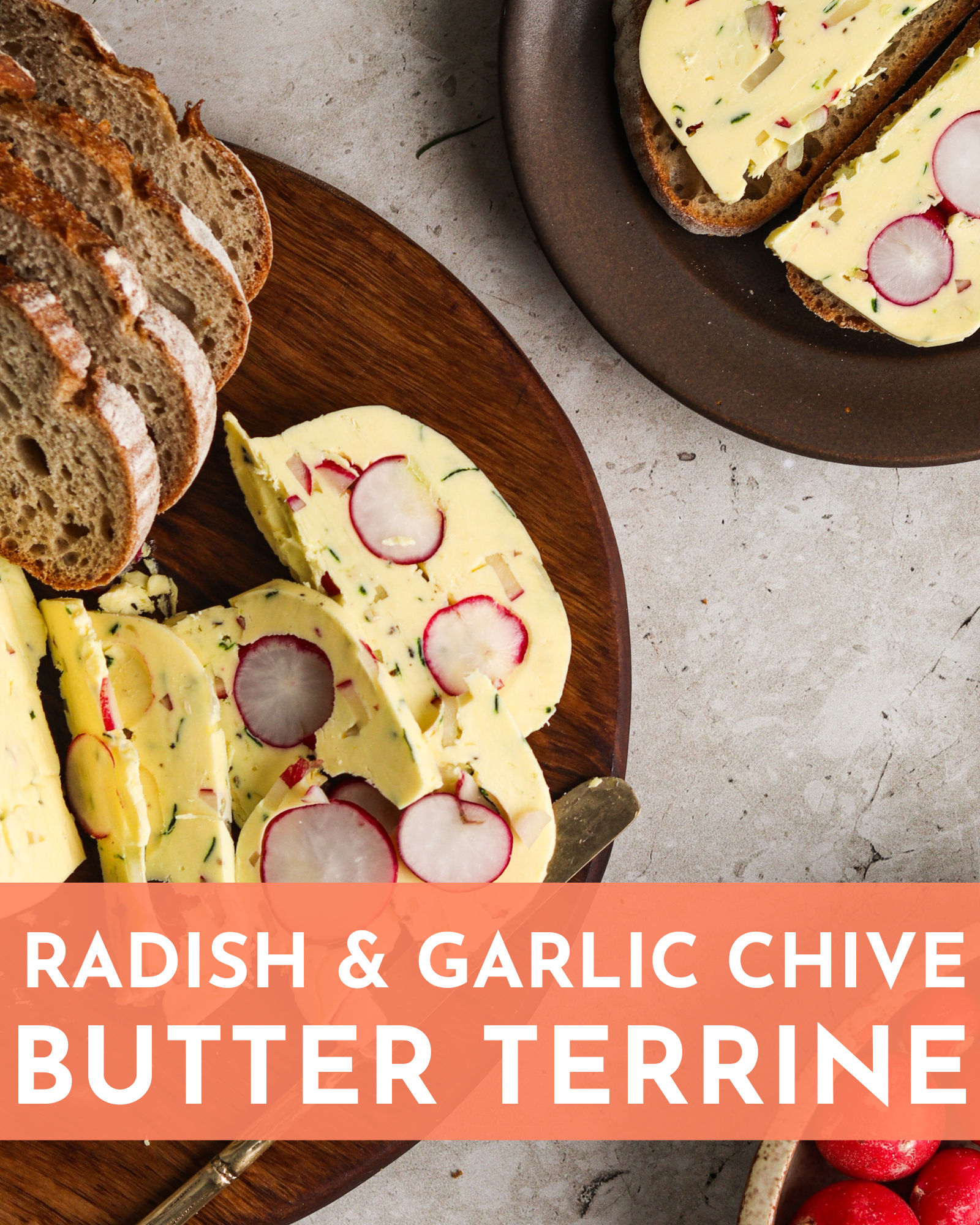Korean Bibimbap (BEE-beem-bop) is a classic – and delicious – dish of steamed rice served with ground meat (pork, beef, turkey or chicken), colorful vegetables, and a fried egg on top. Made in only 30 mins, it’s savory, filling, hearty and served in a big bowl.

Why This Korean Bibimbap Recipe Is So Good
- Bibimbap is a delicious Korean dish with rice, mixed vegetables, meats and topped with an egg.
- Low-carb & Paleo friendly dish, replacing the rice with spiralized & diced daikon radish
- Sizzling, savory dish with the classic ginger, scallions, garlic, soy sauce and sesame oil combination
- 30 minute meal from “Inspiralized Cookbook” by Ali Maffucci
Korean Bibimbap Ingredients
- Lean Ground Pork
- Vegetables: Cucumber, Daikon Radishes, scallions, spinach
- Rice Vinegar
- Ginger
- Garlic
- Sesame Seeds
- Soy Sauce: low-sodium. If you are a strict Paleo – replace the soy sauce with coconut aminos
- Gochujang: Korean Red Pepper Paste. If you prefer your dish less spicy, look for Doenjang.
- Oil: Cooking Oil & Asian Sesame Oil
- Salt & Pepper: To taste
How To Make This Korean Bibimbap – Step By Step
Spiralize the cucumber, set aside. Spiralize the daikon, then pulse daikon in food processor, to make daikon rice.
Whisk together soy sauce, rice vinegar, gochujang, sesame oil and sesame seeds. Then add in ground pork to marinade.
All in the same pan/wok…
Stir fry scallions, ginger, garlic and daikon rice, then remove and cover. Stir fry spinach and set aside. Then fry an egg, keeping yolks running but edges crispy. Set egg aside.
Finally stir fry the marinated pork, breaking it up with a spatula. Evenly divide all ingredients to bowls and top with the egg.
Making A Traditional Korean Bibimbap
Some of the more traditional Korean restaurants will serve Bibimbap in a heavy, thick stone or cast iron bowl. The bowl is heated up first, the a little oil is drizzled in the bowl. Rice is added and pressed down into the hot oil – which then makes the rice delightfully crunchy and crispy on the bottom. Instead of a fried egg, sometimes a raw egg will be cracked on top, and when mixed in with the sizzling rice, coats every grain and cooks gently.
Paleo Friendly Bibimbap
For those looking for a Paleo friendly or low-carb option for this Korean dish, Ali Maffuci, author of Inspiralized: Turn Vegetables into Healthy, Creative, Satisfying Meals and the blog, has created a brilliant alternative for the rice.
Replace the rice with the humble Asian daikon radish.
Surprisingly, when the “minced” daikon radish (using a spiralizer then pulsing in a food processor) is stir fried with ginger and garlic, it transforms into tender, aromatic morsels that easily tags along with accompanying ingredients in the bowl — just like rice.
If you’re living the Paleo lifestyle, or just want to steer clear of rice, pasta and breads, Ali’s Inspiralized Cookbook offers creative recipes that go beyond the normal, “replace spiralized zucchini for the noodles” shtick.
My favorite recipes are the ones that replace the rice – Spicy Seafood-Chorizo Paella and Sweet Potato Fried Rice are next on my list to try.

What Spiralizer Should I Use?
Do you have a vegetable spiralizer? Create ribbons of “noodles” from all types of vegetables including zucchini (we call these zoodles), cucumber, daikon, sweet potatoes and more.
If you don’t know which one to buy, Watch my video review of different vegetable spiralizers and how to use them.
Top Tips For Korean Bibimbap
- You can use white rice for this recipe, but if you want it paleo you can make diakon rice.
- If you prefer your dish less spicy, look for Doenjang paste instead of Gochujang.
- When making cucumber noodles, go for medium width, this gives the noodles a good consistency.
- If you have not got a wok, you need to think about what kind of stove you have. If you have a gas flame, you can have a traditional round-bottomed wok. But if you have an electric cooker, then you do need the kind of wok that has a flat bit at the base.
More Spiralized Vegetable Recipes
Pad Thai Zoodles (Steamy Kitchen)
Vegetables Spiralizer Comparison Video (Steamy Kitchen)
Cauliflower Fried Rice (Steamy Kitchen)
Zucchini Spaghetti, Crispy Prosciutto and Roasted Cauliflower with Lemon-Parmesan Sauce (Inspiralized)
Zucchini Noodles (Zoodles) with Lemon-Garlic Spicy Shrimp (Skinny Taste)
Zucchini “Noodles” with Sesame-Peanut Sauce (Fat Free Vegan)
Spiralized Zucchini Pasta with Creamy Avocado Sauce Recipe (The Watering Mouth)
I love hearing from you! If you have made this tasty Korean Bibimbap, be sure to leave me a star rating and a comment below!

Korean Bibimbap
Ingredients
- 1 large cucumber
- 2-3 large daikon radishes peeled
- 1 tablespoon low-sodium soy sauce
- 1 1/2 teaspoons rice vinegar
- 2 tablespoons gochujang Korean red pepper paste
- 1 teaspoon Asian sesame oil
- 2 teaspoons roasted sesame seeds
- 8 ounces lean ground pork
- 1/2 cup diced scallions green and white parts
- 2 tablespoons finely minced garlic
- 1 teaspoon grated fresh ginger
- salt to taste
- 3 packed cups fresh spinach
- 4 large eggs
- Cooking oil vegetable, canola, coconut
Instructions
- Spiralize the cucumber, medium thickness, then set aside in refrigerator to keep cold. Spiralize the daikon radish, thin thickness (blade d). Place the spiralized daikon in a food processor and pulse until resembles size of rice grains. You should have approximately 3 cups of daikon rice.
- In a medium bowl, whisk together the soy sauce, rice vinegar, gochujang, sesame oil and sesame seeds. Add in the ground pork to the bowl and let marinate on counter while you continue with recipe.
- Heat a wok or large saute pan over medium-high heat. When hot, drizzle in cooking oil and swirl to coat pan. Add in the scallions, ginger and garlic. Stir fry for 15 seconds until fragrant. Add in the daikon "rice" and stir fry for about 5 minutes, until the daikon turns transluscent. Season salt to taste and toss well. Remove "rice" from pan, and cover to keep warm.
- Wipe the pan clean. Return pan to medium-high heat. When hot, drizzle in just a little cooking oil. Add in the spinach and stir fry, tossing frequently, for 2 minutes, until spinach is wilted. Remove spinach to plate and set aside.
- Wipe pan clean. Return same pan to medium heat. When hot, swirl in cooking oil. Crack in the eggs and cook without stirring for 3 minutes or until the egg whites are set on the edges. Cover pan, reduce heat to medium-low and cook for an additional 1-2 minutes until the egg whites are cooked through and the yolks still runny. Remove from pan to a plate, and set aside.
- Return same pan to stove, set on high heat. When hot, swirl in cooking oil. Add in the marinated pork, breaking up the pork with your spatula. Cook pork for 4-5 minutes, until no longer pink and pork is cooked through.
- Evenly divide the daikon rice, pork, spinach and cucumber noodles between four bowls. Top each bowl with a fried egg.





That is one tasty looking bowl of bibimbap!
This looks very nice! I love BiBimBamp and look forward to trying it without rice.
I am so looking into every Paleo and low carb option right now! I just find, it’s really hard to keep up this type of diet if you don’t get creative, so I find this recipe quite inspirational and yummy looking. Getting worried, spring break is only 4 weeks away and that Spanx bathing suit just ain’t gonna fit if I don’t make some quick changes!!!
Looks great, but I am pretty sure the Paleo Diet Police are going to come after you because Paleo doesn’t allow soy sauce. A lot of Paleo folks use coconut aminos to replace the soy.
Kalyn – Korean gochujang also contains a little sugar – so the Paleo Police would nix that as well 🙂 But good thing both our blogs were never meant to appeal to the food police, but rather real people, real kitchens LOL